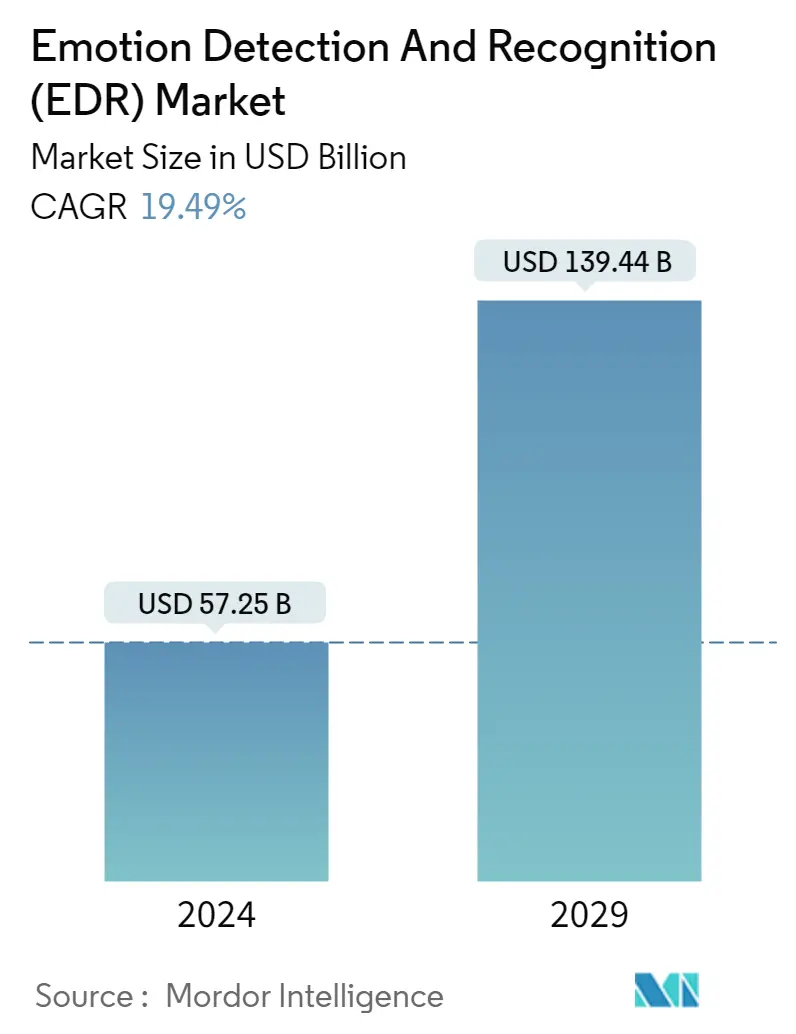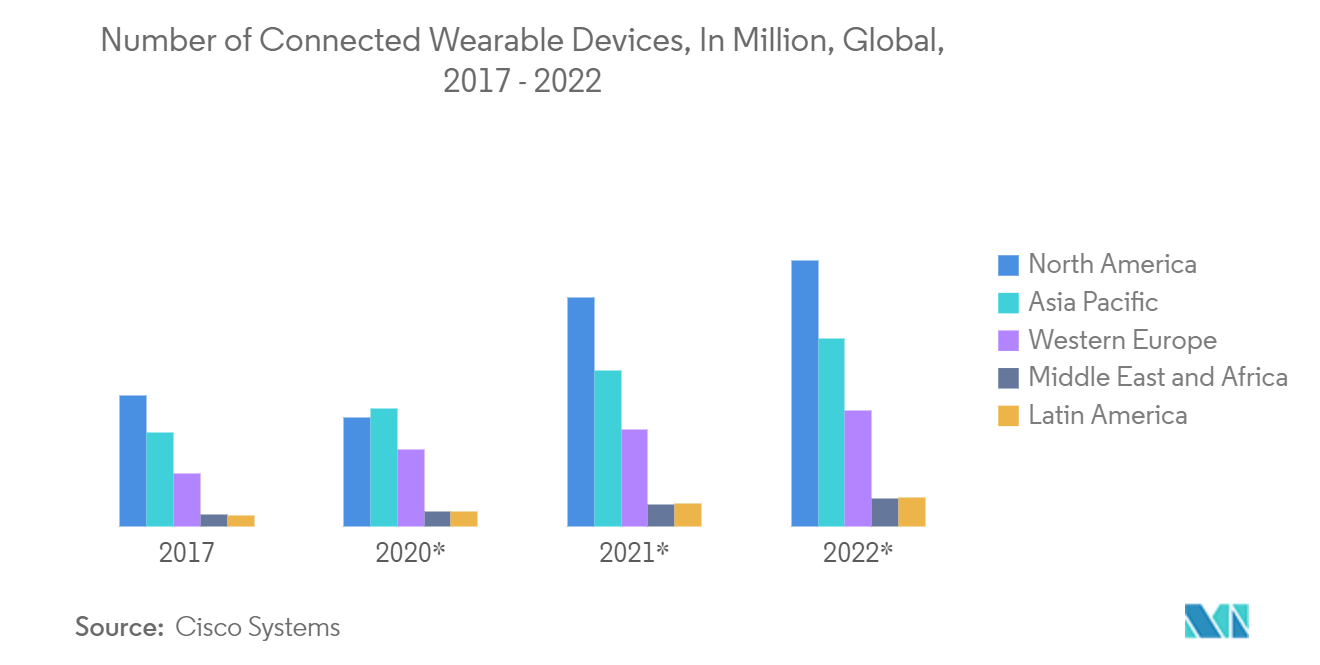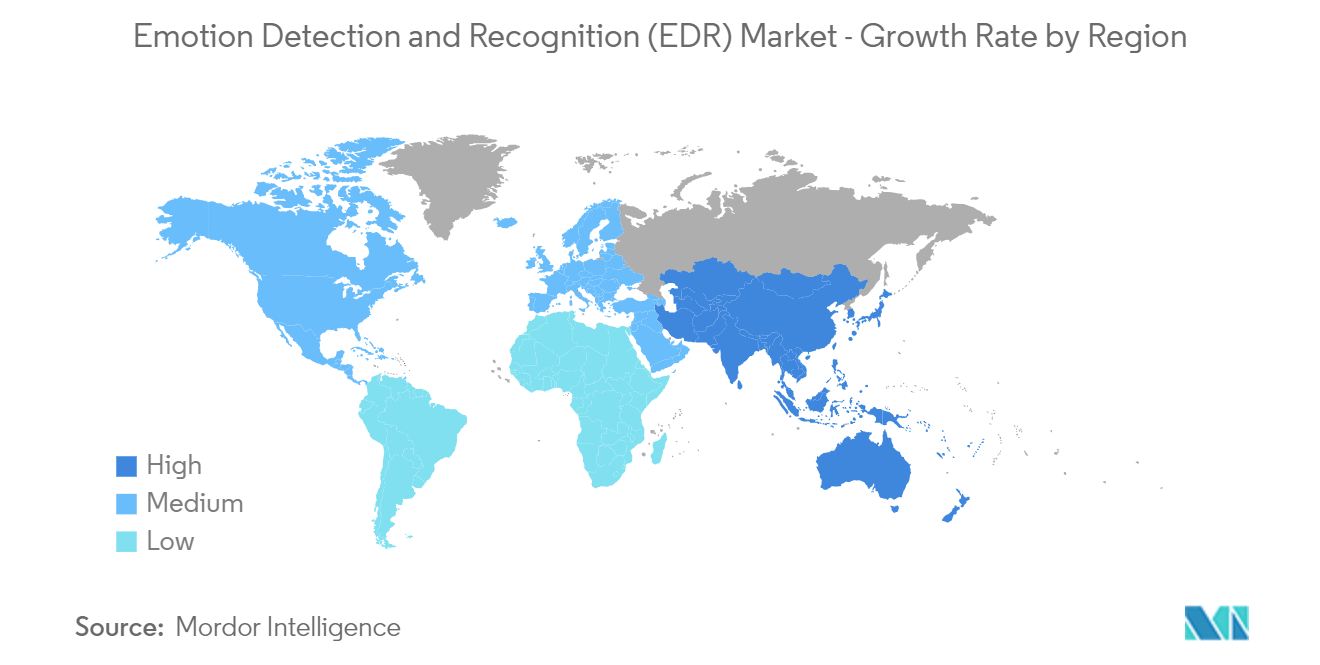Emotion Detection and Recognition (EDR) Market Size

| Study Period | 2019 - 2029 |
| Market Size (2024) | USD 57.25 Billion |
| Market Size (2029) | USD 139.44 Billion |
| CAGR (2024 - 2029) | 19.49 % |
| Fastest Growing Market | Asia Pacific |
| Largest Market | North America |
Major Players_Market_Major_Players_Logo.webp)
*Disclaimer: Major Players sorted in no particular order |
Emotion Detection and Recognition (EDR) Market Analysis
The Emotion Detection And Recognition Market size is estimated at USD 57.25 billion in 2024, and is expected to reach USD 139.44 billion by 2029, growing at a CAGR of 19.49% during the forecast period (2024-2029).
The Emotion Detection and Recognition (EDR) market is a rapidly growing sector that involves developing and implementing technologies capable of identifying and analyzing human emotions. EDR systems utilize various techniques such as facial expression recognition, speech analysis, physiological signals, and natural language processing to detect and interpret emotional states.
- Businesses increasingly recognize the importance of understanding customer emotions to enhance their products, services, and overall customer experience. EDR technologies enable companies to gather valuable insights by analyzing customer emotions and sentiments.
- The widespread use of wearable devices, such as smartwatches and fitness trackers, has created new opportunities for EDR technology. These devices can collect physiological data, such as heart rate and skin conductance, which can be used in emotion detection algorithms.
- The increasing need for advanced marketing tools drives the Emotion Detection and Recognition (EDR) market significantly. Emotion detection and recognition technology enables marketers to gain deeper insights into customer emotions, sentiments, and preferences. Marketers can understand how customers engage with their brand by analyzing emotional responses to marketing campaigns, advertisements, and product experiences. This data helps create more personalized and targeted marketing strategies, improving customer engagement and conversion rates.
- Emotion detection and recognition systems collect and analyze personal data, including facial expressions, voice recordings, physiological signals, and textual data. The collection and use of such sensitive personal information raise privacy concerns. Individuals are becoming increasingly aware of their data rights and are demanding greater control over their personal information.
- Due to COVID-19, the market is slowdown because wearing masks has become necessary for social engagement, interfering with emotional recognition in everyday life. Furthermore, it hindered detection rates because identification rates were lowest under mask settings, and different emotion types were associated with different parts of the face. Post-pandemic, the market is growing rapidly due to increased connected devices.
Emotion Detection and Recognition (EDR) Market Trends
Adoption of IOT driven Wearable Devices Driving the Market Growth
- The increasing connectivity and integration of IoT devices and wearable devices offer a vast amount of data that EDR systems can leverage to provide valuable insights into human emotions. This data-driven approach can revolutionize various industries, including healthcare, gaming, smart homes, and personalized experiences.
- The IoT has revolutionized the way devices and objects connect and communicate with each other. According to GSMA, the global IoT connections are estimated to reach 25 billion by 2025, and the IoT market revenue is expected to cross USD 1.1 trillion by the same period. With the integration of EDR technology into IoT devices, such as smartphones, smart home systems, and connected cars, it becomes possible to detect and analyze emotions in various contexts. For example, IoT-enabled smart home systems can use EDR to understand the emotional state of residents and adjust the environment accordingly for enhanced comfort and well-being.
- Additionally, the number of connected wearable devices is also increasing. Such devices have sensors that collect, monitor, and analyze biological vitals, such as heart rate, pulse, and body temperature. According to Cisco Systems, the number of connected wearable devices globally is expected to reach 1,105 million in 2022.
- Wearable devices, including smartwatches, fitness trackers, and virtual reality headsets, have recently gained significant popularity. These devices often include sensors that collect physiological data, such as heart rate, skin conductance, and body temperature. By analyzing these physiological signals in conjunction with other data, EDR systems can infer the wearer's emotional state. Wearable devices offer a convenient and non-intrusive way to gather data for emotion detection and recognition.
- Integrating EDR technology with IoT and wearable devices has particular relevance in the healthcare and well-being sectors. EDR can be utilized to monitor and analyze the emotional state of patients, providing valuable insights for mental health diagnosis, stress management, and personalized treatment plans. Wearable devices with EDR capabilities can track emotional patterns and help individuals better understand their well-being.
- EDR technology integrated into IoT devices and wearable devices has the potential to enhance user experiences significantly. For instance, EDR can enable virtual environments to adapt to the user's emotional responses in virtual reality applications, creating more immersive and engaging experiences. Additionally, EDR can be used in human-computer interfaces to enable devices and systems to respond intelligently to the user's emotions, improving interaction and overall user satisfaction.

North America is Expected to Register the Largest Market
- North America has been one of the leading regions in market size and growth for EDR technology. The presence of major technology companies, innovative startups, and research institutions has contributed to the development and adoption of EDR solutions in the region. The market has witnessed steady growth driven by the demand for advanced marketing tools, personalized customer experiences, and applications in healthcare and wellness.
- North America has been at the forefront of technological advancements, including artificial intelligence (AI), machine learning (ML), and computer vision, which are critical for developing EDR technology. The region has a robust ecosystem of research and development centers, universities, and tech companies that contribute to the continuous innovation and improvement of EDR systems.
- The IoT connections in the region are expected to reach 5.9 billion by 2025. Such growth is expected to enable marketers to attain authentic consumer insights and improve ad targeting. In line with such growth in the demand for IoT, smart wearables, retail sales, and ad spending, the region does not have major stringent data regulations, which further influences the growth.
- The North America EDR market has been fueled by the increasing need for advanced marketing and advertising tools. By analyzing customer emotions and sentiments, EDR technology enables marketers to create personalized and engaging campaigns, optimize advertising effectiveness, and enhance customer experiences. North American companies across various industries, including retail, e-commerce, and entertainment, are adopting EDR solutions to gain a competitive edge in the market.
- The North America EDR market benefits from the region's technological advancements, strong market demand for advanced marketing tools and personalized experiences, and the application of EDR technology in healthcare. However, companies need to navigate data privacy regulations and address ethical considerations to ensure the responsible and transparent use of EDR technology in the region.

Emotion Detection and Recognition (EDR) Industry Overview
The emotion detection and recognition market is semi-consolidated owing to the presence of multiple vendors in the market. Moreover, market entry for new entrants remains challenging due to higher investment and demand for skilled technicians. Players in the market are adopting strategies such as partnerships and acquisitions to enhance their product offerings and gain sustainable competitive advantage.
- January 2023 - nViso SA (NVISO), one of the leading Human Behavioural Analytics AI businesses, announced that its Neuro SDK would be presented at the Socionext display at CES2023. NVISO has expanded the spectrum of Human Behavioural AI Apps that it supports on the BrainChip Akida event-based, fully digital neuromorphic processing platform by transferring new AI Apps from its portfolio. These features include Action Units, Body Pose, and Gesture Recognition, in addition to the previously announced Headpose, Facial Landmark, Gaze, and Emotion AI Apps with the release of the Evaluation Kit (EVK) version.
Emotion Detection and Recognition (EDR) Market Leaders
-
Affectiva Inc. (Smart Eye)
-
Emotibot Technologies Limited
-
iMotions
-
Noldus
-
Sightcorp.
*Disclaimer: Major Players sorted in no particular order
_Market_Concentration.webp)
Emotion Detection and Recognition (EDR) Market News
- September 2022 - CyberLink Corporation, a provider of AI and facial recognition technology, integrated its FaceMe AI face recognition engine into MediaTek's new Genio AIoT platform. FaceMe now has precise facial recognition capabilities for flexible deployment across different sectors and use cases, including security, smart banking, access control, public safety, and smart retail, owing to the recent MediaTek Genio 1200 integration.
- July 2022 - Secunet, a security and biometrics corporation in Germany, revealed plans to equip Zurich Airport with technology to make the facility compliant with the European Entry/Exit System (EES). Third-country nationals are required to register with a face image and four fingerprints to pass the Schengen area's land, sea, and air borders under the EES program.
Emotion Detection and Recognition (EDR) Market Report - Table of Contents
1. INTRODUCTION
- 1.1 Study Assumptions and Market Definition
- 1.2 Scope of the Study
2. RESEARCH METHODOLOGY
3. EXECUTIVE SUMMARY
4. MARKET INSIGHTS
- 4.1 Market Overview
-
4.2 Industry Attractiveness - Porter's Five Forces Analysis
- 4.2.1 Bargaining Power of Suppliers
- 4.2.2 Bargaining Power of Buyers/Consumers
- 4.2.3 Threat of New Entrants
- 4.2.4 Threat of Substitutes
- 4.2.5 Intensity of Competitive Rivalry
- 4.3 Technology Snapshot
-
4.4 Market Drivers
- 4.4.1 Adoption of IOT driven Wearable Devices
- 4.4.2 Increasing Need for Advanced Marketing Tools
-
4.5 Market Challenges
- 4.5.1 Data Privacy Concerns and data Regulation Adoption across the World
- 4.6 Assessment of Impact of COVID-19 on the Market
5. MARKET SEGMENTATION
-
5.1 By Software and Services
- 5.1.1 Software
- 5.1.1.1 Facial Recognition
- 5.1.1.2 Speech and Voice Recognition
- 5.1.1.3 Bio-sensing
- 5.1.2 Services
-
5.2 By End-user Vertical
- 5.2.1 Government
- 5.2.2 Healthcare
- 5.2.3 Retail
- 5.2.4 Entertainment
- 5.2.5 Transportation
- 5.2.6 Other End-user Verticals
-
5.3 By Geography
- 5.3.1 North America
- 5.3.1.1 United States
- 5.3.1.2 Canada
- 5.3.2 Europe
- 5.3.2.1 Germany
- 5.3.2.2 France
- 5.3.2.3 United Kingdom
- 5.3.2.4 Rest of Europe
- 5.3.3 Asia Pacific
- 5.3.3.1 India
- 5.3.3.2 China
- 5.3.3.3 Japan
- 5.3.3.4 Rest of Asia Pacific
- 5.3.4 Latin America
- 5.3.4.1 Brazil
- 5.3.4.2 Argentina
- 5.3.4.3 Rest of Latin America
- 5.3.5 Middle East & Africa
- 5.3.5.1 UAE
- 5.3.5.2 South Africa
- 5.3.5.3 Rest of Middle East and Africa
- 5.3.6 Rest of the world
6. COMPETITIVE LANDSCAPE
-
6.1 Company Profiles
- 6.1.1 Affectiva Inc. (Smart Eye)
- 6.1.2 Emotibot Technologies Limited
- 6.1.3 iMotions
- 6.1.4 Noldus
- 6.1.5 Sightcorp.
- 6.1.6 Realeyes OU
- 6.1.7 NVISO SA
- 6.1.8 Kairos AR Inc.
- 6.1.9 Nemesysco Ltd
- 6.1.10 audEERING GMBH
- *List Not Exhaustive
7. INVESTMENT ANALYSIS
8. MARKET OPPORTUNITIES AND FUTURE TRENDS
** Subject To AvailablityEmotion Detection and Recognition (EDR) Industry Segmentation
Emotion detection recognition (EDR) is a method used for detection and recognition of human emotions with the incorporation of technological capabilities, such as facial recognition, speech and voice recognition, biosensing, machine learning, and pattern recognition. The study under consideration explores the global market for both EDR software and services that are capable of recognizing basic emotions (anger, contempt, disgust, fear, joy, sadness, and surprise).
The Emotion Detection and Recognition (EDR) Market is Segmented by Software and Services (Software (Facial Recognition, Speech and Voice Recognition, and Bio-sensing), Services), by End-user Vertical (Government, Healthcare, Retail, Entertainment, Transportation, Others), by Geography (North America, Europe, Asia Pacific, Rest of the World). The market sizes and forecasts are provided in terms of value in USD for all the above segments.
| By Software and Services | Software | Facial Recognition |
| Speech and Voice Recognition | ||
| Bio-sensing | ||
| By Software and Services | Services | |
| By End-user Vertical | Government | |
| Healthcare | ||
| Retail | ||
| Entertainment | ||
| Transportation | ||
| Other End-user Verticals | ||
| By Geography | North America | United States |
| Canada | ||
| By Geography | Europe | Germany |
| France | ||
| United Kingdom | ||
| Rest of Europe | ||
| By Geography | Asia Pacific | India |
| China | ||
| Japan | ||
| Rest of Asia Pacific | ||
| By Geography | Latin America | Brazil |
| Argentina | ||
| Rest of Latin America | ||
| By Geography | Middle East & Africa | UAE |
| South Africa | ||
| Rest of Middle East and Africa | ||
| By Geography | Rest of the world |
Emotion Detection and Recognition (EDR) Market Research FAQs
How big is the Emotion Detection And Recognition (EDR) Market?
The Emotion Detection And Recognition (EDR) Market size is expected to reach USD 57.25 billion in 2024 and grow at a CAGR of 19.49% to reach USD 139.44 billion by 2029.
What is the current Emotion Detection And Recognition (EDR) Market size?
In 2024, the Emotion Detection And Recognition (EDR) Market size is expected to reach USD 57.25 billion.
Who are the key players in Emotion Detection And Recognition (EDR) Market?
Affectiva Inc. (Smart Eye), Emotibot Technologies Limited, iMotions, Noldus and Sightcorp. are the major companies operating in the Emotion Detection And Recognition (EDR) Market.
Which is the fastest growing region in Emotion Detection And Recognition (EDR) Market?
Asia Pacific is estimated to grow at the highest CAGR over the forecast period (2024-2029).
Which region has the biggest share in Emotion Detection And Recognition (EDR) Market?
In 2024, the North America accounts for the largest market share in Emotion Detection And Recognition (EDR) Market.
What years does this Emotion Detection And Recognition (EDR) Market cover, and what was the market size in 2023?
In 2023, the Emotion Detection And Recognition (EDR) Market size was estimated at USD 47.91 billion. The report covers the Emotion Detection And Recognition (EDR) Market historical market size for years: 2019, 2020, 2021, 2022 and 2023. The report also forecasts the Emotion Detection And Recognition (EDR) Market size for years: 2024, 2025, 2026, 2027, 2028 and 2029.
Emotion Detection and Recognition Industry Report
Statistics for the 2024 Emotion Detection and Recognition market share, size and revenue growth rate, created by Mordor Intelligence™ Industry Reports. Emotion Detection and Recognition analysis includes a market forecast outlook to 2029 and historical overview. Get a sample of this industry analysis as a free report PDF download.



